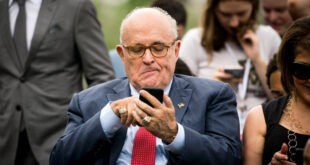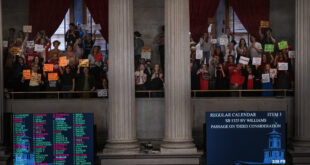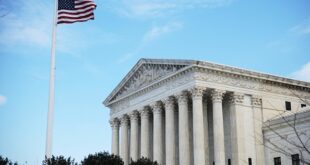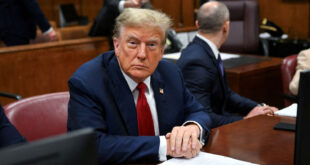The Movement for Black Lives (M4BL) released a report on Wednesday detailing the history of policing and describing how the Department of Justice (DOJ) under former President Donald Trump targeted Black Lives Matter protestors to interfere with last summer’s demonstrations.
“We want to really show how the U.S. government has continued to persecute the Black movement by surveillance, by criminalizing protests, and by using the criminal legal system to prevent people from protesting and punishing them for being engaged in protests by attempting to curtail their First Amendment rights,” Amara Enyia, Policy Research Coordinator for The Movement for Black Lives, said.
“It is undeniable that racism plays a role,” Enyia said. “It is structurally built into the fabric of this country and its institutions, which is why it’s been so difficult to eradicate. It’s based on institutions that were designed around racism and around the devaluing of Black people and the devaluing of Black lives.”
The racial justice organization investigated 326 criminal cases from around the United States. The group partnered with Creating Law Enforcement Accountability & Responsibility Clinic (CLEAR) at the City University of New York School of Law. The two researched cases filed by federal prosecutors from May 31, 2020, to October 25, 2020.
The organizations found that the Department of Justice was given instructions from President Trump, former Attorney General William Barr, and other high-ranking officials.
The report says that the government agency “exploited the expansive federal criminal code in order to assert federal jurisdiction in cases that bore no federal interest.” Most of the defendants charged in the federal criminal cases were given harsher sentences. 52% of the defendants were identified as Black.
“The known proportion of Black defendants compared to the proportion of Black people in the United States, per the latest census data, indicates that Black defendants were dramatically overrepresented,” the report said.
“These directives, meant to disrupt the movement, were the primary reason for the unprecedented federalization of protest-related prosecutions seen in 2020,” the report said.
“[T]he empirical data and findings in this report largely corroborate what Black organizers have long know intellectually, intuitively, and from lived experience about the federal government’s disparate policing and prosecution of racial justice protests and related activity.”
The nationwide uprise was triggered by the gruesome murder of George Floyd by Minneapolis police officer Derek Chauvin. The police officer was caught on video camera kneeling on Floyd’s neck for eight minutes and forty-six seconds as the crowd around him screamed for him to stop.
Last June, President Trump admitted to Fox News that he struggled to watch the video of Floyd being murdered.
“The George Floyd case, nothing has to be said. I watched that,” the former President said. “I couldn’t really watch it for that long a period of time, it was over eight minutes. Who could watch that?”
The Black Lives Matter movement quickly became the focal point of mainstream politics and protests continued throughout the summer. President Trump referred to the protestors as “thugs” and blamed Democratic leadership for the trouble.
“BLM Protestors horribly harass elderly Pittsburgh diners, scaring them with loud taunts while taking their food rights off their plate. These anarchists, not protestors, are Biden voters, but he has no control and nothing to say. Disgraceful. Never seen anything like it. Thugs,” President Trump tweeted.
“We saw U.S. Attorney General Bill Barr overnight go from expressing some level of sympathy for racial justice protestors to labeling them as radical and violent agitators with absolutely no basis for that sort of characterization,” Ramzi Kassem, founding director of CLEAR and law professor at the City University of New York, said. “All of this was very transparently aimed at disrupting a Black-led movement for social justice that was happening both spontaneously and in an organized fashion nationwide.”
Chicago, Illinois; Portland, Oregon’ Las Vegas, Nevada; Minneapolis, Minnesota; and Washington D.C. had the most number of charges against protestors.
The Movement for Black Lives and Creating Law Enforcement Accountability & Responsibility clinic at City University of New York School of Law wants the government to apologize for its long history of racism and compensate the people that have been damaged by it through reparations.
The biggest question now is whether President Joe Biden will make good on his promises and help the same people who voted him into office. President Biden has thanked Black Americans for helping him to win on numerous occasions. According to Vox, President Biden received 90% of Black votes.
“I mean it, especially in those moments and especially for those moments when this campaign was at its lowest ebb, the African American community stood up again for me. You’ve always had my back, and I’ll have yours.”
The George Floyd Justice in Policing Act is a comprehensive bill that will hold police officers accountable for misconduct and other offenses, restrict certain police practices, collect data, make it difficult for officers that are fired to move to other departments in the nation, and require more in-depth training for police officers nationwide.
President Biden was aiming for Congress to pass the bill on May 25, 2020, the one-year anniversary of Floyd’s death. The House passed the bill along party lines in March, but it has stalled in the Senate.
The report, entitled “Struggle For Power: The Ongoing Persecution of Black Movement By The U.S. Government,” can be read in its entirety here.
 Poli Alert Political & Civics
Poli Alert Political & Civics



